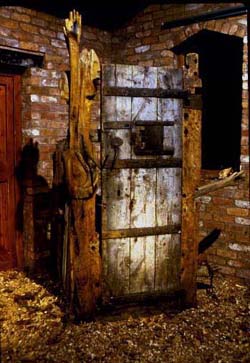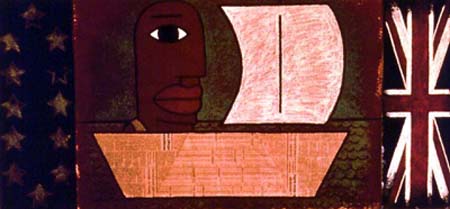|
Enter Gallery 1 |
Exhibited nationwide from 1989 through 1990, the show was Britain's first major exploration of the work of British artists of color. This was one of many shows organized by artists themselves, who recognized the necessity of creating their own outlets for the public presentation of their work.
Artistic movements in Britain have also helped spark interest in the work of
Britain's artists of color. One particularly significant development was the
Caribbean Artists Movement, a literary and visual arts movement begun in 1966
by the writers Ed (later Kamau) Brathwaite, John LaRose and Andrew Salkey.

AUBREY WILLIAMS
Later initiatives included the Black women's arts movement begun in the 1980s by Lubaina Himid, who organized groundbreaking exhibitions such as 5 Black Women at the Africa Centre, Black Woman Time Now at the Battersea Arts Centre and the seminal exhibition The Thin Black Line at the Institute of Contemporary Art (ICA). Through her curatorial efforts and the establishment of a gallery called The Elbow Room, Himid brought attention to emerging and now well-known artists such as Sutapa Biswas, Sonia Boyce, Ingrid Pollard and Veronica Ryan. Eddie Chambers organized more than thirty exhibitions featuring the work of artists of color in the 1980s and 1990s and established the African and Asian Visual Artists Archive, now part of the University of East London. Sunil Gupta's stimulating curatorial projects included Fabled Territories, which featured work by photographers of South Asian origin living in Britain, and Disrupted Borders, which challenged political, racial and sexual categories that continue to define and promulgate dichotomies of centrality and marginality.

Juginder Lamba initiated and organized the South Asian Visual Arts Festival, in which over sixty contemporary artists having origins in Bangladesh, India, Pakistan and Sri Lanka exhibited their work in twenty major venues throughout the West Midland region in 1993. Other artists banded together to create organizations such as Panchayat Arts Education Resource Unit, founded in 1988 by Bhajan Hunjan, Shaheen Merali, Symrath Patti, Allan de Souza and Shanti Thomas to promote the work of predominantly South Asian artists. These are just a few of the zealous efforts organized by artists during the past thirty years which assured that the work of artists of color were placed in Britain's cultural realm.
Despite these initiatives, there remains, here in North America, a tremendous lack of knowledge about the history of people of color living in Britain, and hence a particular unfamiliarity with visual artists living and working in England. When I first began this project, I went to England with the idea of presenting the work of ten to twelve artists whom I had admired for several years: Ronald Moody, Aubrey Williams, Rotimi Fani-Kayode, Lubaina Himid, Keith Piper, Ingrid Pollard, Sonia Boyce and others. After a number of month-long visits, meeting with artists, scholars and arts administrators throughout the country, I discovered a wealth of artists creating thoughtful, inquisitive and visually stimulating work, employing a wide variety of media and exploring numerous stylistic modes.
My subsequent discussions with other Americans about my ideas for this
project were often met with the following recurrent and resounding
question: "Are there many black people in England?"
 Rotimi Fasni-Kayode
Rotimi Fasni-Kayode
